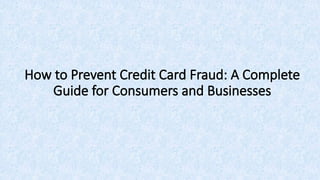How to Prevent Credit Card Fraud A Complete Guide for Consumers and Businesses.pptx
- 1. How to Prevent Credit Card Fraud: A Complete Guide for Consumers and Businesses
- 2. Introduction Credit card fraud is a growing threat in today’s digital economy. Whether you’re a consumer shopping online or a business processing card transactions, understanding how to prevent credit card fraud is essential. With new scams emerging daily, awareness and prevention can save you from financial losses and reputational damage. In this guide, we’ll walk you through actionable tips for protecting yourself and your business, highlight red flags, and introduce tools that can reduce your risk of fraud and chargebacks. What is Credit Card Fraud? Credit card fraud involves the unauthorized use of a credit card to make purchases or access funds. It can happen due to data breaches, card skimming, phishing attacks, or
- 3. Common Types of Credit Card Fraud Understanding the different forms of credit card fraud helps in creating prevention strategies: Card-Not-Present (CNP) Fraud – Used for online or phone transactions without physical card Skimming Devices – Installed on ATMs or POS systems to steal card data Phishing Scams – Emails or SMS pretending to be banks or businesses Account Takeover – Hacker gains access to cardholder’s account details Chargeback Fraud – Also known as “friendly fraud,” where buyers dispute legitimate charges Want to avoid costly disputes? Read our chargeback guide to learn how to handle and prevent chargebacks effectively.
- 4. How to Prevent Credit Card Fraud (For Consumers) Here are essential tips every credit card holder should follow: ✅ Use two-factor authentication (2FA) for online transactions ✅ Never share card details via email, phone, or social media ✅ Regularly monitor your card statements for unauthorized charges ✅ Shop only on secure websites (HTTPS) with trusted payment gateways ✅ Set up real-time alerts for every transaction ✅ Avoid public Wi-Fi when making purchases ✅ Report lost/stolen cards immediately
- 5. Credit Card Fraud Prevention Tips for Businesses Businesses must take proactive steps to protect customer data and reduce fraudulent transactions: ✔️Use a PCI-compliant payment processor ✔️Enable AVS (Address Verification System) and CVV verification ✔️Install fraud detection tools that analyze behavioral patterns ✔️Train staff on how to spot phishing and social engineering scams ✔️Use tokenization to mask sensitive credit card information ✔️Avoid storing full card numbers or CVV codes ✔️Set order limits and flag high-risk transactions for review
- 6. Signs of Credit Card Fraud Watch for these warning signs to detect fraud early: ❗ Unexpected SMS OTPs or verification messages ❗ Small "test" charges from unknown merchants ❗ Large purchases in different locations within short time ❗ Sudden card decline due to suspicious activity ❗ Unfamiliar merchants listed on your statement
- 7. Technologies That Help Prevent Fraud Modern tools help detect and prevent fraud with automation: 🔐 Tokenization – Replaces card data with secure tokens 🧠 AI & Machine Learning – Real-time transaction monitoring 📍 Geo-location tracking – Alerts for transactions from unexpected locations 🛑 Velocity checks – Flags multiple rapid transactions What to Do if You're a Victim If you suspect or confirm fraud, act fast: 🚨 Call your card provider to block the card 📝 Dispute the charges and file a fraud report ️ ♂️ 🕵️ ️ 🕵️ ️ 🕵️ ️ 🕵️ ️ 🕵️ ️ 🕵️ ️ 🕵️ ️ 🕵️ ️ 🕵️ ️ 🕵️ ️ 🕵️ ️ 🕵️ ️ 🕵️ ️ 🕵️ ️Monitor your credit report for suspicious activity 🧊 Consider freΙezing your credit as a precaution
- 8. FAQs About Credit Card Fraud Prevention ❓What is the safest way to use a credit card online? Always use secure websites (HTTPS), avoid public Wi-Fi, and enable two-factor authentication for payments. ❓How can businesses protect against chargeback fraud? Use AVS and CVV checks, gather signed proof of delivery, and implement strong return/refund policies. For more, read our chargeback guide. ❓What is card-not-present fraud? It's a type of fraud that occurs when the physical card is not used—common in online or phone purchases. ❓What are the best tools to detect credit card fraud? Fraud detection software, AI-based transaction monitoring, and tokenization services are highly effective. ❓How do I know if my card details have been compromised? Watch for small unauthorized transactions, changes in account login behavior, or alerts from your credit card company.
- 9. Final Thoughts Preventing credit card fraud requires proactive habits, both from consumers and businesses. By adopting security best practices, staying informed, and using the right technologies, you can significantly reduce the risk of fraud and financial loss. If you’re a business owner, choosing the right payment processor can make a huge difference. Implementing a system that’s PCI compliant, supports fraud detection, and helps avoid chargeback losses is crucial.
- 10. Thank you










